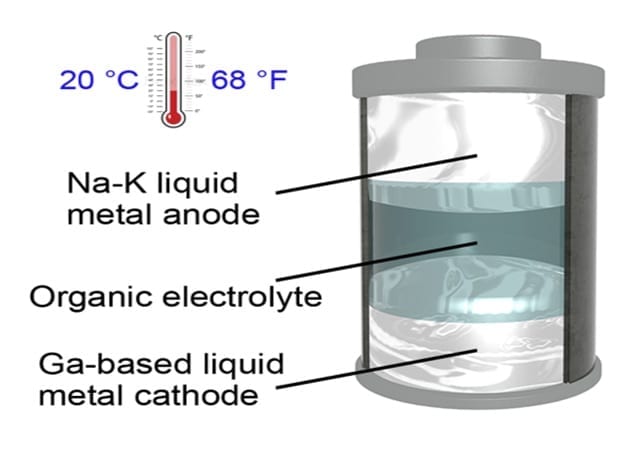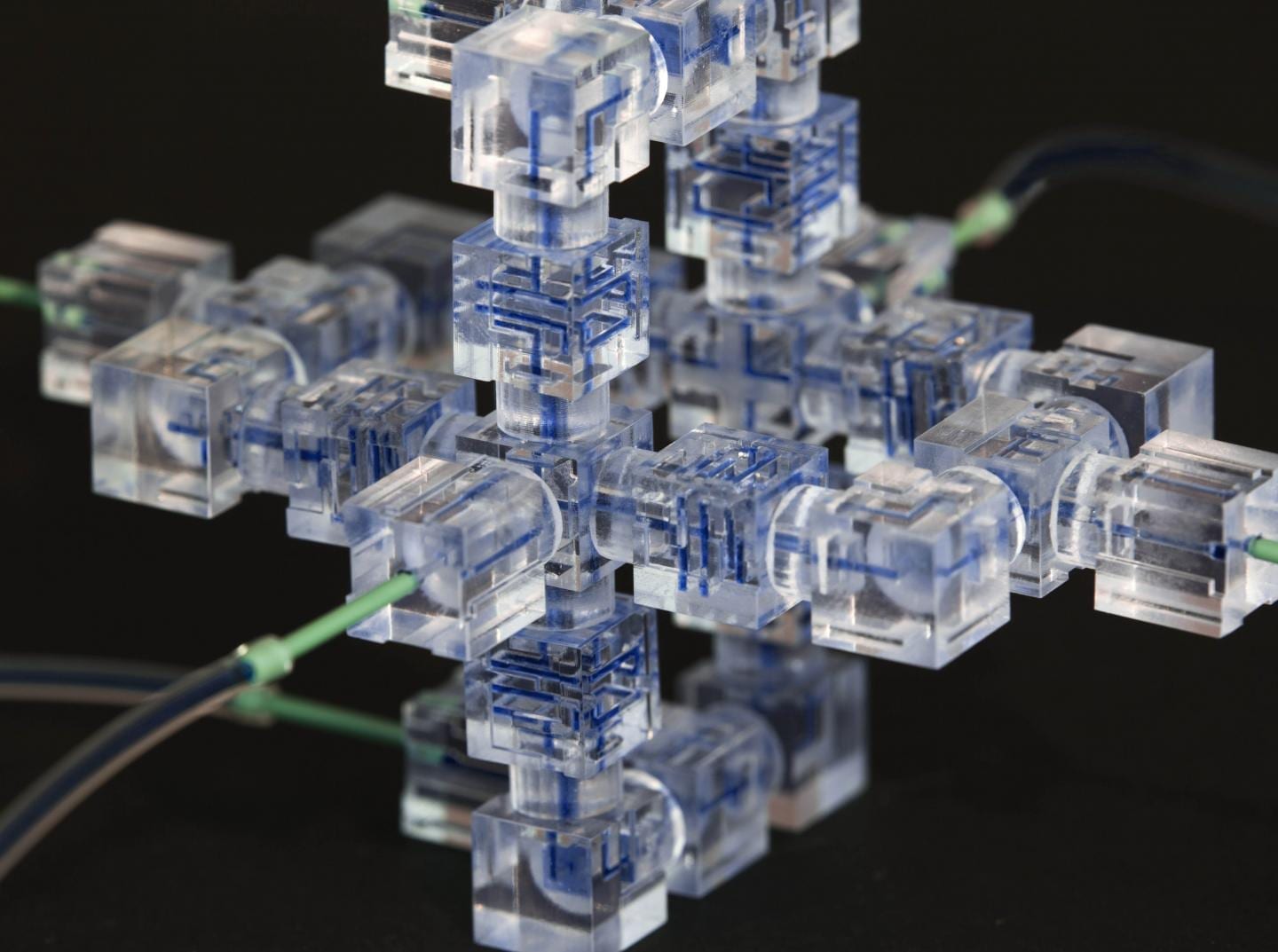
Cheaper, longer-lasting materials could enable batteries that make wind and solar energy more competitive.
Researchers at MIT have improved a proposed liquid battery system that could enable renewable energy sources to compete with conventional power plants.
Donald Sadoway and colleagues have already started a company to produce electrical-grid-scale liquid batteries, whose layers of molten material automatically separate due to their differing densities. But the new formula — published in the journal Nature by Sadoway, former postdocs Kangli Wang and Kai Jiang, and seven others — substitutes different metals for the molten layers used in a battery previously developed by the team.
Sadoway, the John F. Elliott Professor of Materials Chemistry, says the new formula allows the battery to work at a temperature more than 200 degrees Celsius lower than the previous formulation. In addition to the lower operating temperature, which should simplify the battery’s design and extend its working life, the new formulation will be less expensive to make, he says.
The battery uses two layers of molten metal, separated by a layer of molten salt that acts as the battery’s electrolyte (the layer that charged particles pass through as the battery is charged or discharged). Because each of the three materials has a different density, they naturally separate into layers, like oil floating on water.
The original system, using magnesium for one of the battery’s electrodes and antimony for the other, required an operating temperature of 700 C. But with the new formulation, with one electrode made of lithium and the other a mixture of lead and antimony, the battery can operate at temperatures of 450 to 500 C.
Extensive testing has shown that even after 10 years of daily charging and discharging, the system should retain about 85 percent of its initial efficiency — a key factor in making such a technology an attractive investment for electric utilities.
Currently, the only widely used system for utility-scale storage of electricity is pumped hydro, in which water is pumped uphill to a storage reservoir when excess power is available, and then flows back down through a turbine to generate power when it is needed. Such systems can be used to match the intermittent production of power from irregular sources, such as wind and solar power, with variations in demand. Because of inevitable losses from the friction in pumps and turbines, such systems return about 70 percent of the power that is put into them (which is called the “round-trip efficiency”).
Sadoway says his team’s new liquid-battery system can already deliver the same 70 percent efficiency, and with further refinements may be able to do better. And unlike pumped hydro systems — which are only feasible in locations with sufficient water and an available hillside — the liquid batteries could be built virtually anywhere, and at virtually any size. “The fact that we don’t need a mountain, and we don’t need lots of water, could give us a decisive advantage,” Sadoway says.
The Latest on: Liquid metal battery
[google_news title=”” keyword=”Liquid metal battery” num_posts=”10″ blurb_length=”0″ show_thumb=”left”]
via Google News
The Latest on: Liquid metal battery
- Marlborough battery tech company files for Chapter 11 bankruptcyon May 9, 2024 at 2:45 am
One of the largest clean energy companies in Massachusetts filed for Chapter 11 bankruptcy this week, citing its inability to raise cash to complete the buildout of a battery facility in Milford.
- New Progress in Sodium-ion Battery Electrolyte Researchon May 8, 2024 at 7:16 am
On May 7th, the Dalian Institute of Chemical Physics of the Chinese Academy of Sciences announced new progress in the research of sodium-ion battery electrolytes. The sodium vanadium ...
- Bill Gates-backed technology company files Chapter 11 bankruptcyon May 7, 2024 at 10:43 pm
A company backed by Bill Gates' venture investment firm Gates Frontier, Paulson Partners and Reliance New Energy has filed for Chapter 11 bankruptcy.
- EV Battery Recycling Gains Momentumon May 7, 2024 at 8:06 am
Despite the EU's regulatory moves, it is EV powerhouse China that leads the pack in battery recycling. According to the Boston Consulting Group, it boasts a recycling capacity exceeding half a million ...
- Innovative New Tech is Transforming the Battery Marketon May 7, 2024 at 8:00 am
The battery market is brimming with game-changing innovations, promising higher energy density, faster charging, and greener production methods.
- Bill Gates-Backed Ambri Files for Bankruptcy With Plans to Sell Itselfon May 6, 2024 at 11:38 am
The battery developer entered chapter 11 blaming a challenging fundraising environment and fallout from an ill-fated effort to become a manufacturer.
- Battery developer backed by Paulson, Gates files for bankruptcyon May 6, 2024 at 10:26 am
Ambri was founded in 2010 by two researchers who developed a “liquid metal” battery while at the Massachusetts Institute of Technology.
- Researchers discover spontaneous liquefaction of solid metal–liquid metal interfaces in colloidal binary alloyson May 6, 2024 at 7:37 am
The boundary between solid metal and liquid metal can be much less "solid" than we ever suspected. RMIT researchers have discovered that the liquid-solid boundary can fluctuate back and forth, with ...
- Liquid-membrane battery innovator finds new investoron May 3, 2024 at 7:18 am
Skip Technology Inc, a U.S.-based innovator focusing on effective energy storage technology, announced that Puyallup Tribal Enterprises (PTE) has become the ...
- Lenovo debuts stunning 16-inch ultraportable laptop rival to Apple's MacBook Pro, cooled by liquid metal — this ThinkPad weighs less than 2Kg, has a massive user replaceable ...on May 1, 2024 at 10:51 am
Lenovo has taken the wraps off its sleek, lightweight, and power-packed ThinkPad P1 Gen 7.The new laptop supports up to a Core Ultra 9 185H CPU and users can choose between integrated Intel Arc ...
via Bing News










